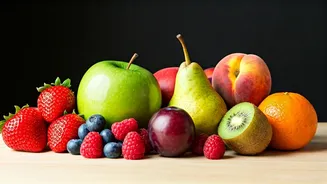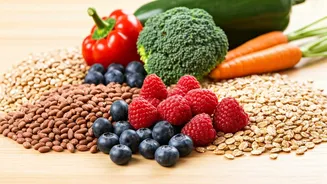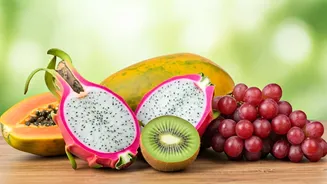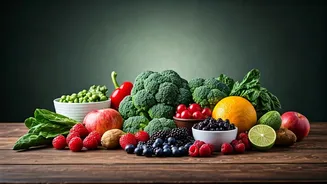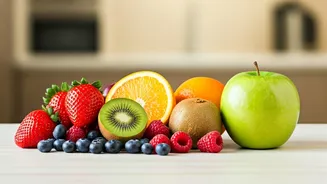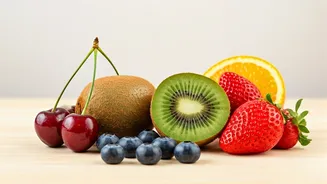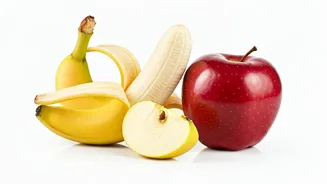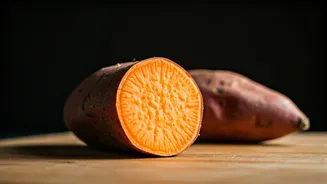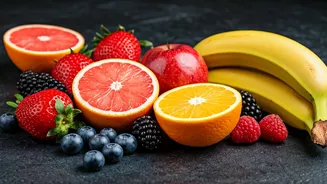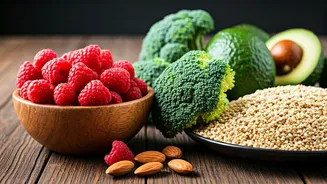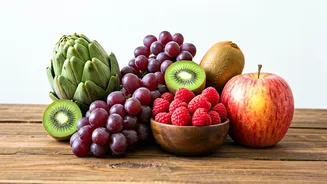Introduction to Fruits
Fruits are often viewed with caution by individuals managing diabetes due to their natural sugar content. However, not all fruits are created equal. Many
fruits possess a low glycemic index (GI), meaning they cause a slower and steadier rise in blood sugar levels. Furthermore, fruits provide essential vitamins, minerals, and fiber, contributing to overall health. Incorporating the right fruits into a diabetic diet can aid in managing blood sugar, promoting weight management, and boosting overall well-being. The key is to choose fruits wisely and consume them in moderation. The list below unveils some of the best fruit choices. Remember to consult a healthcare provider or a registered dietitian for personalized dietary advice. Always be mindful of portion sizes and monitor blood sugar levels after eating fruit to understand their individual impact on your body.
Berries: Powerhouses
Berries are exceptional choices for individuals with diabetes due to their low GI and high antioxidant content. Strawberries, for example, are packed with Vitamin C and fiber, making them a delicious and nutritious option. Blueberries are loaded with antioxidants that can help combat inflammation and improve insulin sensitivity. Raspberries are another excellent choice, providing a good source of fiber, which aids in slowing down the absorption of sugar and preventing blood sugar spikes. Blackberries offer similar benefits, contributing to overall health. These berries are also relatively low in carbohydrates, making them ideal for blood sugar control. Consume berries fresh, frozen, or added to salads and smoothies, as a part of a balanced diet. Remember that portion control is crucial, even with these healthy options. Aim for a moderate serving size to keep blood sugar levels stable.
Cherries: Sweet Treat
Cherries, while sweet, can be incorporated into a diabetic-friendly diet in moderation. They have a lower GI compared to many other fruits. Cherries are rich in antioxidants and can potentially aid in reducing inflammation. They provide fiber and Vitamin C, offering several health benefits. The key is to consume them mindfully. Choose fresh or frozen cherries without added sugar. Be careful about portion size; a small serving is recommended to avoid significant impacts on blood sugar. Cherries can be a delightful addition to desserts and snacks, as long as blood sugar levels are monitored. Consulting a healthcare professional can help you personalize cherry consumption within your diabetic management plan.
Apples: Fiber-Rich Choice
Apples, especially when eaten with the skin, are a good source of fiber, which can help regulate blood sugar levels. Fiber slows down the digestion of sugars and promotes a steadier rise in glucose. Apples are also rich in vitamins and minerals, contributing to overall health. The GI of apples can vary depending on the variety, so choosing those with lower GI scores is advisable. Eating an apple with a protein or healthy fat source can further help manage blood sugar. Apples can be a satisfying snack or a component of a meal, offering both sweetness and nutrients. Always consume apples in moderation and be aware of your body's response, especially in terms of blood sugar.
Pears: Similar Benefits
Similar to apples, pears are another excellent fruit option due to their fiber content and nutritional value. Pears have a moderate GI and provide important vitamins and minerals. Pears aid in managing blood sugar and promoting digestive health. As with apples, consuming pears with the skin provides additional fiber. The fiber helps regulate blood sugar levels by slowing down the absorption of sugar. Pears can be eaten as a snack or included in meals, but portion control is essential. Select pears that are ripe but not overly ripe, as overripe fruits tend to have higher sugar concentrations. Ensure that you track your body’s response to pears and consult your healthcare provider for further guidance.
Peaches: Sweet and Safe
Peaches are another delicious fruit that can be enjoyed in moderation within a diabetic diet. Peaches provide fiber and essential vitamins. They typically have a moderate GI, making them a safer choice compared to some other fruits. Fresh peaches are preferable to canned peaches, which may contain added sugars. A small to moderate portion of peaches can be included as a snack or dessert. Be mindful of how your body responds to peaches and incorporate them as part of a balanced eating plan. Pairing peaches with a protein source, like nuts or yogurt, can help manage blood sugar levels. Always check your blood glucose after consumption.
Oranges: Vitamin Boost
Oranges are excellent sources of Vitamin C and offer fiber, making them a favorable choice for individuals with diabetes. Oranges have a moderate GI and can be included in a balanced diet. The fiber content in oranges helps slow down sugar absorption, which assists in controlling blood sugar spikes. Eating whole oranges is better than drinking orange juice because juice lacks fiber and might lead to quicker sugar absorption. Ensure to limit portion size; moderation is important. Oranges can be part of a snack, added to salads, or consumed in any way you prefer. Always consider how oranges affect your blood sugar by monitoring your blood glucose levels after consumption.
Kiwi: Unique Benefits
Kiwis are a nutritional powerhouse, featuring a low GI. Kiwis offer various vitamins, minerals, and antioxidants, and are excellent for health. They have a relatively low carbohydrate count, making them a safe choice. Kiwis can be an amazing addition to smoothies, salads, or eaten on their own. Since they have good nutritional value, they are perfect for diabetic diets. They can provide essential nutrients with minimal effect on blood sugar. Moderation is important, as always. Monitor blood glucose levels after consumption. The inclusion of kiwis in a balanced diet can support overall well-being, while still providing a great taste.
Plums: Antioxidants Abound
Plums are another excellent fruit choice that is suitable for people with diabetes, as they have a moderate GI and deliver fiber. They are loaded with antioxidants and vitamins, which is why they are a healthy option. Plums can promote good blood sugar control. Fresh plums are preferred over dried plums because dried fruits may have higher sugar concentrations. Consume plums in moderation, and make sure to include them as part of a balanced diet. Plums are a convenient snack and they are also a great addition to your meals. Make sure to watch your blood glucose levels to track how your body responds to them.
Guava: Tropical Delight
Guava is a unique tropical fruit that has a low glycemic load and a high fiber content, which makes it suitable for individuals with diabetes. Guavas help in regulating blood sugar levels. They are packed with essential vitamins and minerals, promoting overall health. Fresh guava is always preferable over guava juice because the juice does not contain fiber. Consume guava in moderation. Make sure it is consumed as part of a balanced and healthy diet. Guava can be enjoyed as a snack or in salads, providing a delicious way to incorporate nutrients into your diet. Keep track of how guava affects your blood sugar levels after consumption.
